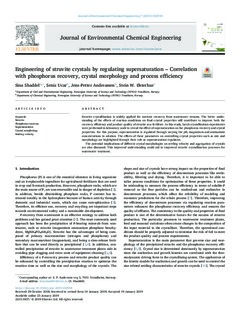| dc.contributor.author | Shaddel, Sina | |
| dc.contributor.author | Ucar, Seniz | |
| dc.contributor.author | Andreassen, Jens-Petter | |
| dc.contributor.author | Østerhus, Stein Wold | |
| dc.date.accessioned | 2019-09-04T06:31:45Z | |
| dc.date.available | 2019-09-04T06:31:45Z | |
| dc.date.created | 2019-02-12T21:53:16Z | |
| dc.date.issued | 2019 | |
| dc.identifier.citation | Journal of Environmental Chemical Engineering. 2019, 7 (1), 102918. | nb_NO |
| dc.identifier.issn | 2213-3437 | |
| dc.identifier.uri | http://hdl.handle.net/11250/2612336 | |
| dc.description.abstract | Struvite crystallization is widely applied for nutrient recovery from wastewater streams. The better understanding of the effects of reaction conditions on final crystal properties will contribute to improve both the recovery efficiency and product quality of struvite as a fertilizer. In this study, batch crystallization experiments were performed in laboratory scale to reveal the effect of supersaturation on the phosphorus recovery and crystal properties. For this purpose, supersaturation is regulated through varying the pH, magnesium and ammonium concentrations in solution. The effects of these parameters on controlling crystal properties such as size and morphology are highlighted through their role as supersaturation regulators.
The potential implications of different crystal morphologies on settling velocity and aggregation of crystals are also discussed. This improved understanding could aid in improved struvite crystallization processes for wastewater treatment. | nb_NO |
| dc.language.iso | eng | nb_NO |
| dc.publisher | Elsevier | nb_NO |
| dc.relation.haspart | Journal of Environmental Chemical Engineering. | nb_NO |
| dc.rights | Attribution-NonCommercial-NoDerivatives 4.0 Internasjonal | * |
| dc.rights.uri | http://creativecommons.org/licenses/by-nc-nd/4.0/deed.no | * |
| dc.title | Engineering of struvite crystals by regulating supersaturation – Correlation with phosphorus recovery, crystal morphology and process efficiency | nb_NO |
| dc.type | Journal article | nb_NO |
| dc.type | Peer reviewed | nb_NO |
| dc.description.version | publishedVersion | nb_NO |
| dc.source.volume | 7 | nb_NO |
| dc.source.journal | Journal of Environmental Chemical Engineering | nb_NO |
| dc.source.issue | 1 | nb_NO |
| dc.identifier.doi | 10.1016/j.jece.2019.102918 | |
| dc.identifier.cristin | 1676657 | |
| dc.description.localcode | Open Access CC-BY-NC-ND | nb_NO |
| cristin.unitcode | 194,64,91,0 | |
| cristin.unitcode | 194,66,30,0 | |
| cristin.unitname | Institutt for bygg- og miljøteknikk | |
| cristin.unitname | Institutt for kjemisk prosessteknologi | |
| cristin.ispublished | true | |
| cristin.fulltext | original | |
| cristin.qualitycode | 1 | |

